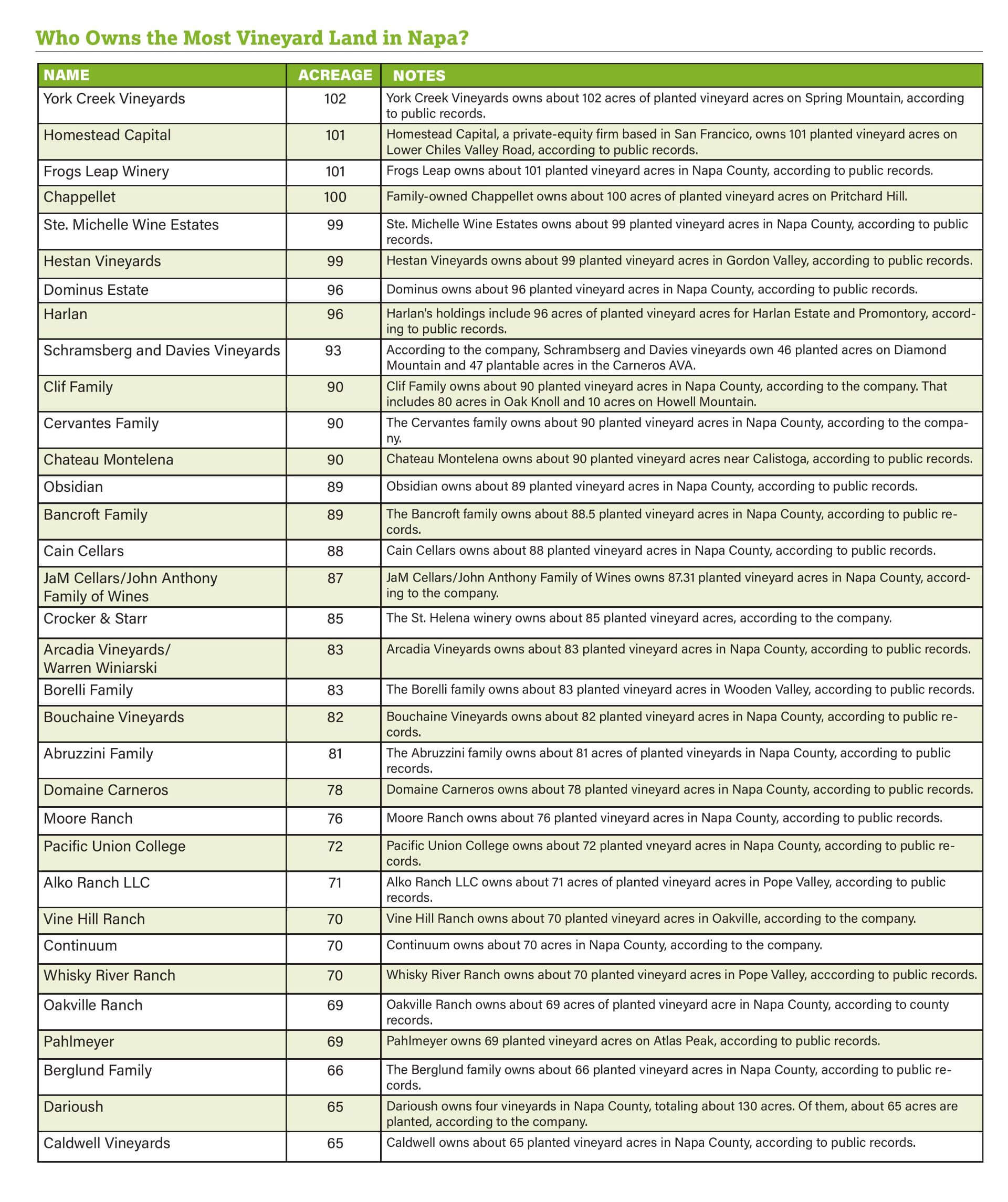Wine Business
Who Owns the Most Vineyard Land in Napa?

In 2017, WineBusiness Monthly ran a list of the top vineyard landowners in Napa Valley; as the region is “planted out,” it seemed important to understand who was responsible for stewarding, planting and, importantly, farming this land.
Since then, more than a few vineyards have changed hands through mergers and acquisitions, and the time was right for an update. This article will review some of the major transactions over the last few years that have helped reshape vineyard ownership in the valley.
While Treasury Americas apparently farms the most land, the Laird family owns the most planted vineyard acreage in Napa County, according to research conducted by WineBusiness Monthly. Resources to compile the list of the top 100 winegrape growers included Napa County assessor and public records, Napa County Agricultural Commissioner data and the Napa County Online Public Map, as well as company and other grower representatives.
The Laird family’s vineyard holdings include about 2,400 planted vineyard acres, according to the company. The family farms up and down Napa County, with vineyards in Carneros, on the Napa Valley floor and in the hillsides. The family’s portfolio took three decades to build, noted Rebecca Laird, general manager at Laird family Estate.
Another top grower is the Silverado Investment Management Co. (SIMCO), a group that works with pension and investment funds. SIMCO oversees about 2,500 planted vineyard acres, according to the company.
The Gamble family still controls 600 planted vineyard acres which are leased to Treasury Wine Estates. The family has been farming in Napa County since 1916. The land was handed down to Tom Gamble by his grandfather. Gamble also farms another 175 planted vineyard acres on a 230-acre property. Other longtime grape growers include Charles Krug and the Mondavi family. Still, new owners and companies continue to invest in Napa winery and vineyard properties.
Of course, while some families continue to farm, there have been some major transactions over the past few years that have reshaped vineyard ownership in Napa Valley.
Multiple acquisitions involved well-known family-owned wineries, including Joseph Phelps Vineyards by LVMH Moet Hennessy Louis Vuitton and Rombauer Family Vineyards by Gallo, the world’s largest winery.
In August 2023, Gallo purchased Rombauer Family Vineyards, which comprised 700 acres of vineyards in Carneros, Atlas Peak, Calistoga, St. Helena, Sonoma Valley and the Sierra Foothills. In Napa County alone, Rombauer has 95 planted vineyard acres, according to public records.
Gallo now owns 1,500 planted vineyard acres in Napa County. Gallo’s other holdings in the Napa Valley include Louis M. Martini, William Hill Estates and Stagecoach, a 600-acre contiguous vineyard.
Antinori Napa Valley gained another 250 planted vineyard acres in 2023 with the purchase of the remainder of Ste. Michelle Wine Estates’ holdings in Stag’s Leap Wine Cellars.
There are other relatively new investors as well.
Lawrence Wine Estates, a company owned by billionaire Gaylon Lawrence, has been buying prime properties, since 2018, when it acquired Heitz Cellars. It has since added multiple properties to its portfolio and now owns close to 600 planted vineyard acres.
Other Napa County acquisitions by Lawrence have included Burgess Cellars, which was purchased in September 2020 shortly before the Glass Fire destroyed the Howell Mountain winery. The winery is now at the former Luna facility on the Silverado Trail near Napa. Then in December 2020, Lawrence bought Stony Hill in the Spring Mountain District.
Other companies that are investing in Napa include the French luxury group LVMH Moet Hennessy Louis Vuitton, Chandon’s owner. The company purchased Joseph Phelps in June 2022. The winery is east of St. Helena.
In the quest to create more vineyard land in the county, there have been fights over land use and the future of agriculture-a conflict that is likely to continue. That means vineyard development may become increasingly difficult. A number of vineyard and winery projects have run into hurdles.
In 2023, a longstanding land-use battle over the development of a 209-acre vineyard at Walt Ranch and a 2,300-acre property owned by vintners Walt and Kathryn Hall ended when the Halls sold the land to the Napa County Land Trust, which paid for the land with grants. The Halls donated more than 25% of the value of the property.
In August, the Napa County Board of Supervisors refused to support the Le Colline vineyard project near Angwin, citing, among other reasons, the property location along Conn Creek and Linda Falls Preserve, known for its waterfall. The owners sought to develop 20 acres of vineyards out of 88 acres. The board, which included two newly elected supervisors-Joelle Gallagher and Anne Cottrell-voted 3-2 to side with the Center for Biological Diversity which opposed the vineyard development and had appealed the project’s approval. Proponents said the site was appropriate for the proposed family-owned vineyard, citing multiple environmental studies. Supporters said Le Colline had been modified to protect Linda Falls Preserve. However, many community members remained opposed to the project.
“This project is utterly inappropriate along what is currently a pristine stretch of Conn Creek, and it is simply impossible to mitigate the significant environmental impacts that will result should this vineyard development were to be allowed,” wrote vintner Beth Novak Milliken.



